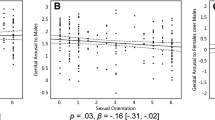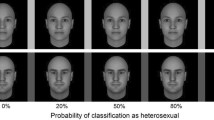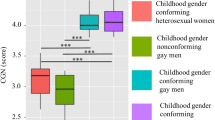Abstract
Both handedness and dermatoglyphic asymmetry reflect early, prenatal influences and both have been reported to be associated with male sexual orientation; handedness has been related to female sexual orientation as well. Neurohormonal and developmental perturbation are two competing hypothesis that attempt to explain these connections. We attempted to replicate these associations and to extend dermatoglyphic asymmetry findings to women. Dermatoglyphic directional asymmetry and fluctuating asymmetry were unrelated to sexual orientation. Homosexual women, but not homosexual men, had highly significant increases in non–right-handedness compared with same-sex heterosexual controls. Although this pattern of results does not allow resolution of the two competing models, it does lend additional support to a biological basis of sexual orientation.
Similar content being viewed by others
REFERENCES
Achs, R., Harder, R. C., & Siegel, M. (1966). Unusual dermatoglyphic findings associated with rubella embryopathy. New England Journal of Medicine, 274, 148-150.
Adams, M. S., & Niswander, J. D. (1967). Developmental "noise" and a congenital malformation. Genetic Research, 10, 313-317.
Andermann, E., Dansky, L., Andermann. F., & Loughan, P. M. (1981). Dermatoglyphic changes and minor congenital malformations associated with maternal use of anticonvulsant drugs during pregnancy. In M. Dam, L. Gram, & J. K. Perry (Eds.), Advances in epileptology: 12th Epilepsy International Symposium (pp. 613-620). New York: Raven.
Annett, M. (1985). Left, right, hand, and brain: The right shift theory. Hillsdale, NJ: Erlbaum.
Bailey, J. M., Dunne, M. P., & Martin, N. G. (2000). Genetic and environmental influences on sexual orientation and its correlates in an Australian twin sample. Journal of Personality and Social Psychology, 78, 524-536.
Bailey, J. M., Gaulin, S., Agyei, Y., & Gladue, B. A. (1994). Effects of gender and sexual orientation on evolutionarily relevant aspects of human mating psychology. Journal of Personality and Social Psychology, 66, 1081-1093.
Bailey, J. M., & Zucker, K. J. (1995). Childhood sex-typed behavior and sexual orientation: A conceptual analysis and quantitative review. Developmental Psychology, 31, 43-55.
Bailey, J. M., & Pillard, R. C. (1991). A genetic study of male sexual orientation. Archives of General Psychiatry, 48, 1089-1096.
Bishop, D. V. M. (1990). Handedness and developmental disorders. Oxford, England: Blackwell Scientific.
Bouchard, T. J., Lykken, D. T., McGue, M., Segal, N. L., & Tellegen, A. (1990). Sources of human psychological differences: The Minnesota study of twins reared apart. Science, 250, 223-228.
Bryden, M. P., McManus, I. C., & Bulman-Fleming, M. B. (1994). Evaluating the empirical support for the Geschwind-Behan-Galaburda model of cerebral lateralization. Brain and Cognition, 26, 103-167.
Byne, W., & Parsons, B. (1993). Human homosexuality: The biologic theories reappraised. Archives of General Psychiatry, 50, 228-239.
Byne, W., Tobet, S., Mattiace, L., Lasco, M. S., Kemether, E., Edgar, M. A., Morgello, S., Buchsbaum, M. S., & Jones, L. B. (2001). The interstitial nuclei of the human anterior hypothalamus: An investigation of variation with sex, sexual orientation, and HIV status. Hormones and Behavior, 40, 86-92.
Byyny, R. L., Orth, D. N., & Cohen S. (1972). Radioimmunoassay of epidermal growth factor. Endocrinology, 90, 1261-1266.
Clark, M. M. (1957). Left-handedness: Laterality characteristics and their educational implications. London: University of London Press.
Cohen, J. (1983). The cost of dichotomization. Applied Psychological Measurement, 7, 249-253.
Coren, S. (1993). Measurement of handedness via self-report: The relationship between brief and extended inventories. Perceptual and Motor Skills, 76, 1035-1042.
Cummins, H., & Midlo, C. (1961). Finger prints, palms, and soles. New York: Dover.
Dittmar, M. (1998). Finger ridge-count asymmetry and diversity of Andean Indians and interpopulation comparisons. American Journal of Physical Anthropology, 105, 377-393.
El-Hani, C. N., Moreira, L. M. A., Souza, A. L.V., Silva, M. S., Forastieri, V., & Andrade, C. P. (in press). Evidence against a relationship between dermatoglyphic asymmetry and male sexual orientation. Human Biology.
Ellis, L., & Ames, M. A. (1987). Neurohormonal functioning and sexual orientation:Atheory of homosexuality/heterosexuality. Psychological Bulletin, 101, 233-258.
Geschwind, N., & Galaburda, A. M. (1985). Cerebral lateralization: Biological mechanisms, association and pathology: A hypothesis and a program for research. I-III. Archives of Neurology, 43, 428-459, 521-552, 634-654.
Gangestad, S. W., Yeo, R. A., Shaw, P., Thoma, R., Daniel, W. F., & Korthank, A. (1996). Human leukocyte antigens and hand preference: Preliminary observations. Neuropsychology, 10, 432-428.
Gladue, B. A., & Bailey, J. M. (1995). Sexual orientation and aggressiveness. Psychoneuroendocrinology, 20, 475-485.
Green, M. F., Bracha, H. S., Satz, P., & Christenson, C. D. (1994). Preliminary evidence for an association between minor physical anomalies and second trimester neurodevelopment in schizophrenia. Psychiatry Research, 53, 119-127.
Green, R., & Young, R. (2000). Fingerprint asymmetry in male and female transsexuals. Personality and Individual Differences, 29, 933-942.
Hall, J. A. Y., & Kimura, D. (1994). Dermatoglyphic asymmetry and sexual orientation in men. Behavioral Neuroscience, 108, 1203-1206.
Hall, L. S. (2000a). Dermatoglyphic analysis of monozygotic twins discordant for sexual orientation. In N. M. Durham, K. M. Fox, & C. C. Plato (Eds.), The state of dermatoglyphics: The science of finger and palm prints (Vol. 2, pp. 123-165). Lewiston, NY: The Edwin Mellen Press.
Hall, L. S. (2000b). Dermatoglyphic analysis of total ridge count in female monozygotic twins discordant for sexual orientation. Journal of Sex Research, 37, 315-320.
Hamer, D. H., Hu, S., Magnuson, V. L., Hu, N., & Pattatucci, A. M. L. (1993). A linkage between DNA markers on the X chromosome and male sexual orientation. Science, 261, 321-327.
Helleday, J., Siwers, B., Ritzer, E. M., & Hugdahl, K. (1994). Normal lateralization for handedness and ear advantage in verbal dichotic listening task inwomen with congenital adrenal hyperplacia (CAH). Neuropsychologia, 32, 875-880.
Hepper, P. G., Shahidullah, S., & White, R. (1991). Handedness in the human fetus. Neuropsychologia, 29, 1107-1111.
Holt, S. B. (1968). The genetics of dermal ridges. Springfield, IL: Charles CThomas.
Hu, S., Pattatucci, A., Patterson, C., Li, L., Fulker, D., Cherny, S., et al. (1995). Linkage between sexual orientation and chromosome Xq28 in males but not in females. Nature Genetics, 11, 248-256.
Jamison, S. C. (1988). Palmar dermatoglyphics in dyslexia. American Journal of Physical Anthropology, 76, 505-513.
Jamison, C. S., Jamison, P., & Meier, R. (1994). Effects of prenatal testosterone administration of palmar dermatoglyphic intercore ridge counts of Rhesus monkeys (Macaca mulatta). American Journal of Physical Anthropology, 94, 409-419.
Jamison, C. S., Meier, R., & Campbell, B. C. (1993). Dermatoglyphic asymmetry and testosterone levels in normal males. American Journal of Physical Anthropology, 90, 185-198.
Kelso, W. M., Nicholls, M. E. R., Warne, G. L., & Zacharin, M. (2000). Cerebral lateralization and cognitive functioning in patients with congenital adrenal hyerplasia. Neuropsychology, 14, 370-378.
Kinsey, A. C., Pomeroy, W. B., & Martin, C. E. (1948). Sexual behavior in the human male. Philadelphia: Saunders.
Kimura, D., & Carson, M.W. (1993). Cognitive pattern and finger ridge asymmetry. Society for Neuroscience Abstracts, 19, 560.
Korsching, S., & Thoenen, H. (1983). Nerve growth factor in sympathetic ganglia and corresponding target organs of rats: Correlation and density of sympathetic innervation. Proceedings of the National Academy of Sciences, USA, 80, 3513-3516.
Lalumière, M. L., Blanchard, R., & Zucker, K. J. (2000). Sexual orientation and handedness in men and women: A meta-analysis. Psychological Bulletin, 126, 575-592.
LeVay, S. (1991). A difference in hypothalamic structure between heterosexual and homosexual men. Science, 253, 1034-1037.
Levi-Montalcini, R., & Angeletti, P. U. (1963). Essential role of the nerve growth factor in the survival and maintenance of dissociated sensory and sympathetic embryonic nerve cells in vitro. Developmental Biology, 7, 653-659.
Loesch, D. Z., Lafranchi, M., & Huggins, R. (1992). A new anthropometric scale for discrimination between sexes. Annals of Human Biology, 19, 177-184.
Markow, T. A., & Gottesman, I. I. (1989). Fluctuating dermatoglyphic asymmetry in psychotic twins. Psychiatry Research, 29, 37-43.
Markow, T. A., & Wandler, K. (1986). Fluctuating dermatoglyphic asymmetry and the genetics of liability to schizophrenia. Psychiatry Research, 19, 323-328.
McCartney, G., & Hepper, P. (1999). Development of lateralized behaviour in the human fetus from 12 to 27 weeks' gestation. Developmental Medicine and Child Neurology, 41, 83-86.
McCormick, C. M., & Witelson, S. F. (1991). A cognitive profile of homosexual men compared to heterosexual men and women. Psychoneuroendocrinology, 16, 459-473.
McFadden, D., & Pasanen, E. G. (1998). Comparison of the auditory systems of heterosexuals and homosexuals: Click-evoked otoacoustic emissions. Proceedings of the National Academy of Sciences, 95, 2709-2713.
McManus, I. C. (1985). Handedness, language dominance, and aphasia: A genetic model. [Monograph] Psychological Medicine (Suppl. 8).
McManus, I. C., & Bryden, M. P. (1991). Geschwind's theory of cerebral lateralization: Developing a formal, causal model. Psychological Bulletin, 110, 237-253.
Mellor, C. S. (1993). Dermatoglyphic evidence of fluctuating asymmetry in schizophrenia. British Journal of Psychiatry, 160, 467-472.
Micle, S., & Kobyliansky, E. (1988). Sex difference in the intraindividual diversity of finger dermatoglyphics: Pattern types and ridge counts. Human Biology, 60, 123-134.
Nass, R., Baker, S., Speiser, P., Virdis, R., Balmaso, S., Cacciari, E., et al. (1987). Hormones and handedness: Left-hand bias in female congenital adrenal hyperplasia patients. Neurology, 37, 711-715.
Naugler, C. T., & Ludman, M. D. (1996). Fluctuating asymmetry and disorders of developmental origin. American Journal of Medical Genetics, 66, 15-20.
Newell-Morris, L. L., Fahrenbruch, G. P., & Sackett, G. P. (1989). Parental psychological stress, dermatoglyphic asymmetry and pregnancy outcomes in the pigtail macaque (Macaca nemestrina). Biology of the Neonate, 56, 61-75.
Nunnally, J., & Bernstein, I. (1994). Psychometric theory. (3rd ed). New York: McGraw Hill.
Palmer, A. R. (1994). Fluctuating asymmetry analyses: A primer. In T. A. Markow (Ed.), Developmental instability: Its origins and evolutionary implications (pp. 335-364). Dordrecht, Netherlands: Kluwer.
Perelle, I. B., & Ehrman, L. (1994). An international study of human handedness. Behavior Genetics, 24, 217-227.
Qazi, Q. H., Masakawa, A., McGann, B., & Woods, J. (1980). Dermatoglyphic abnormalities in the fetal alcohol syndrome. Teratology, 21, 157-160.
Reiss, M., Reiss, G., & Freye, H. A. (1986). Some aspects of self-reported hand preference. Perceptual and Motor Skills, 86, 953-954.
Reiss, M. (1997). Technical aspects of studying motor asymmetry. Wiener Medizinische Wochenschrift, 147, 275-278.
Rice, G., Anderson, C., Risch, N., & Ebers, G. (1999). Male homosexuality: Absence of linkage to microsatellite markers at Xq28. Science, 284, 665-667.
Rose, L. I., Gabbe, S. G., Teicholz, L. E., Villee, D. B., & Williams, G. H. (1972). Dermatoglyphics associated with fetal wastage. New England Journal of Medicine, 287, 451-452.
Searleman, A., Porac, C., & Coren, S. (1989). Relationship between birth order, birth stress, and lateral preference: A critical review. Psychological Bulletin, 105, 397-408.
Seddon, B. M., & McManus, I. C. (1991). The incidence of lefthandedness: A meta-analysis. Unpublished manuscript, Department of Psychology, University College London.
Schachter, S. C. (1994). Handedness in women with intrauterine exposure to diethylstilbestrol. Neuropsychologia, 32, 619-623.
Scheirs, J. G. M., & Vingerhoets, A. J. J. M. (1995). Handedness and other laterality indices in women prenatally exposed to DES. Journal of Clinical and Experimental Neuropsychology, 17, 725-730.
Slabbekoorn, D., van Goozen, S. H., Sanders, G., Gooren, L. J., & Cohen-Kettenis, P. T. (2000). The dermatoglyphic characteristics of transsexuals: Is there evidence for an organizing effect of sex hormones. Psychoneuroendocrinology, 25, 365-375.
Smith, L. L., & Hines, M. (2000). Language lateralization and handedness in women prenatally exposed to diethylstilbestrol (DES). Psychoneuroendocrinology, 25, 497-512.
Tønnessen, F. E. (1997). Testosterone and dyslexia. Pediatric Rehabilitation, 1, 51-58.
Tirosh, E., Rod, R., Cohen, A., & Hochberg, Z. (1993). Congenital adrenal hyperplasia and cerebral lateralizations. Pediatric Neurology, 9, 198-201.
Ward, I. L. (1972). Prenatal stress feminizes and demasculinizes the behavior of males. Science, 175, 82-84.
Ward, I. L., & Weisz, J. (1980). Maternal stress alters plasma testosterone in fetal males. Science, 207, 328-329.
Williams, T. J., Pepitone, M. E., Christensen, S. E., Cooke, B. M., Huberman, A. D., Breedlove, N. J., et al. (2000). Finger-length ratios and sexual orientation. Nature, 404, 455-456.
Witelson, S. F., & Nowakowski, R. S. (1991). Left out axons make men right: A hypothesis for the origin of handedness and functional asymmetry. Neuropsycholgia, 29, 327-333.
Woolf, C. M.,& Gianas, A. D. (1976). Congenital cleft lip and fluctuating dermatoglyphic asymmetry. American Journal of Human Genetics, 28, 400-403.
Woolf, C. M., & Gianas, A. D. (1977). A study of fluctuating asymmetry in the sibs and parents of cleft lip propositi. American Journal of Human Genetics, 29, 503-507.
Wright, H. T., Parker, C. E., & Mavalwala, J. (1972). Unusual dermatoglyphic findings associated with Tomegliac Inclusion Disease in infancy. California Medicine, 116, 14-20.
Yeo, R. A., & Gangestad, S. W. (1993). Developmental origins of variation in human hand preference. Genetica, 89, 281-296.
Yeo, R. A., & Gangestad, S. W. (1998). Developmental instability and phenotypic variation in neural organization. In N. Raz (Ed.), The other side of the error term (pp. 1-51). New York: Elsevier.
Yeo, R. A., Gangestad, S., & Daniel, W. F. (1993). Hand preference and developmental instability. Psychobiology, 21, 161-168.
Zucker, K. J., Bradley, S. J., Oliver, G., Blake, J., Fleming, S., & Hood, J. (1996). Psychosexual development of women with congenital adrenal hyperplasia. Hormones and Behavior, 30, 300-318.
Author information
Authors and Affiliations
Rights and permissions
About this article
Cite this article
Mustanski, B.S., Bailey, J.M. & Kaspar, S. Dermatoglyphics, Handedness, Sex, and Sexual Orientation. Arch Sex Behav 31, 113–122 (2002). https://doi.org/10.1023/A:1014039403752
Issue Date:
DOI: https://doi.org/10.1023/A:1014039403752




